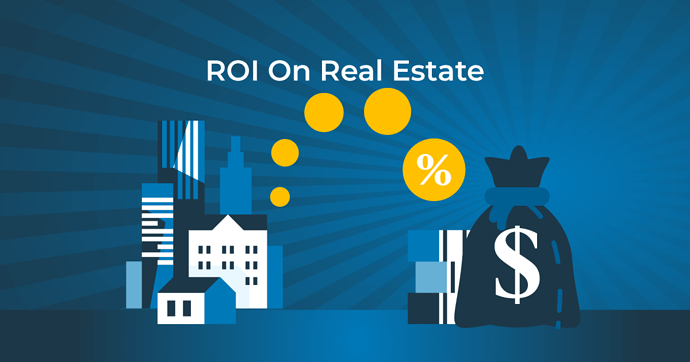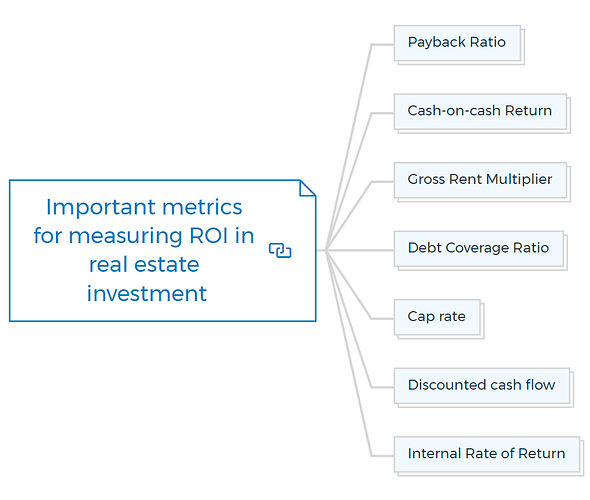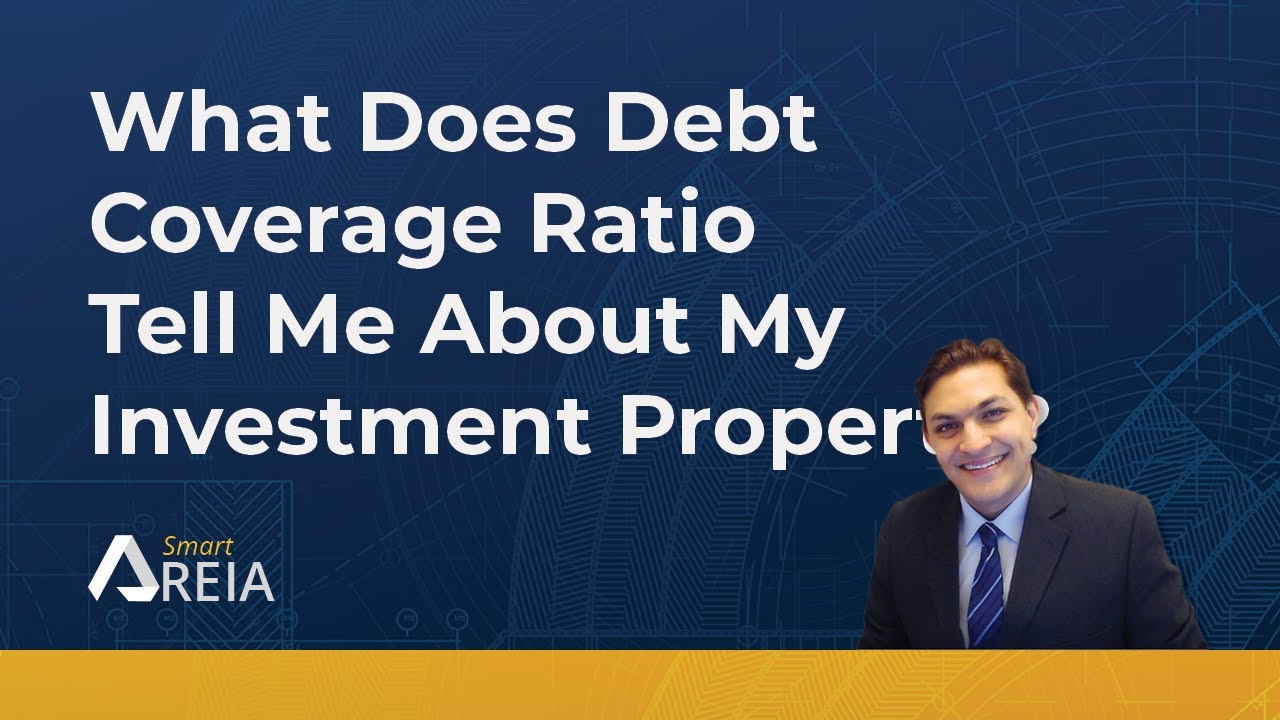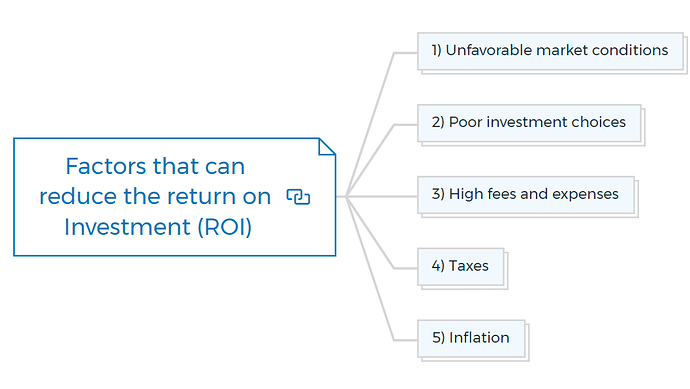Calculating ROI in real estate
When it comes to making money in real estate, ROI is key. In order to be successful, you need to know how to calculate ROI and use it to make smart investment decisions. In this guide, we will walk you through the process of calculating ROI for a real estate investment.
We will also discuss some of the factors that can affect your ROI calculation. By understanding ROI, you will be able to make more informed decisions about your investments and increase your chances of success!
Key Takeaways
- Discounted cash flow analysis is a powerful tool that you can use to value a wide range of investments, including real estate.
- The Discount Rate used in DCF analysis should reflect the required rate of return for a similar investment.
- Future cash flows should be estimated realistically, and all costs associated with an investment should be included.
What is the return on real estate investment analysis?
ROI analysis, or return on real estate investment analysis, is a process of determining whether a real estate investment is worth pursuing.
The analysis considers the potential revenue that the investment could generate and the costs associated with acquiring and developing the property.
In other words, ROI, or return on real estate investment, is a key metric in real estate investing. It measures the profitability of an investment and is typically expressed as a percentage.
In general, real estate returns are measured using the formula -

How to calculate ROI in real estate?
We calculate the real estate return on investment (ROI) as a percentage of the investment cost. You make a net profit of $150,000 if you buy a property for $150,000 and sell it for $300,000.
Because the profit is half of your investment, your return on investment (ROI) is 50%.
The real estate ROI calculations based on the formula with associated expenditures are detailed in the following sections.
Though the equation appears to be easy, it is not. You must also consider numerous variables like maintenance and repairs, which increase with time and leverage borrowed to invest.
As a result, these variables impact the figures in your ROI, leading to various real estate ROI calculation methods.
Methods of real estate ROI calculation
Cost method
The cost method of basic ROI calculation is a popular approach that involves comparing the total costs associated with an investment with the total revenues.
You can do this in several ways, including by looking at the cash flow statements, income statements, and financial ratios like return on investment or net present value.
In cash transactions, assets purchased entirely with cash, we use the cost technique of ROI. It’s a straightforward approach to determining ROI. There are no monthly mortgage payments to consider since there are none.
Real Estate ROI calculation formula -
For example, you paid $200,000 for a property. A total of $70,000 has been spent on closing and upkeep. If you sell the house for $4,00,000, your return on investment will be as follows:
ROI = [$400,000 - (200,000 + 70,000)]/270,000 X 100
= 48%
It is important to note that this method is based solely on quantitative data, meaning it does not consider qualitative factors such as intangibles or strategic positioning.
Additionally, this approach may not always accurately reflect investments since it does not consider the time value of money and depreciated values over time.
However, despite its limitations, the cost method remains a useful way to compare different investment opportunities and determine which one provides the best return for your business.
You are missing out if you haven’t yet subscribed to our YouTube channel.
Out-of-pocket method
The out-of-pocket method is one way to calculate your return on investment (ROI) in real estate and is often used by real estate investors.
To use this method, take the total cash you have invested in a property and subtract any money you have received from renting or selling the property. The result is your net cash investment.
You can then compare this amount to the property’s current market value to determine your ROI.
For example, you purchased a rental property for $200,000 and put $25,000 down. After paying all closing costs and necessary repairs, your total cash investment in the property is $70,000. If you sold it for $400,000, your net cash investment would be 76%.
ROI = [(400,000 - 95,000)/400,000] X 100
ROI = 76%
It’s important to note that you will incur some costs when selling a property. These costs typically include real estate fees and taxes. For this reason, the out-of-pocket method is a good way to calculate ROI in a short period but may not give an accurate long-term perspective.
Important metrics for measuring ROI in real estate investment
Payback ratio
The payback period is one of the oldest and most basic indicators. We define it as the time it takes to recoup our initial monetary investment.
Imagine you put down $200,000 in cash to buy a $700,000 house. The remainder is, of course, financed.
The property generates a $25,000 annual positive cash flow. As a result, the payback time is 8 years.
Your property must have a high positive cash flow to ensure a speedy repayment. The sooner you receive your money back, the sooner you can start “making” money. The sooner, the better.
The repayment phase has been dubbed the “bingo year,” perhaps because the wise and sophisticated investor would cry “bingo!” after seeing the Prodigal Down Payment. The investor in the above case would have referred to year 5 as his bingo year.
This method has a flaw in that it does not account for the time value of money. It considers a dollar received—or invested—today to be just as valuable as a dollar received—or invested—tomorrow.
Returning to the previous example, if the property had no cash flow for 7 years and then $200,000 in year 8, the payback would still be eight years.
You would, however, have missed out on the opportunity to earn and reinvest $25,000 every year for the first 7 years. Even if you had reinvested the early cashflows at money market rates, you would have accumulated some interest by year 8.
A $200,000 payback over eight years isn’t always as wonderful as another.
Learn More
Cash-on-cash Return
The “cash-on-cash return” is a method that is similar to the payback period. This method involves comparing the cash flow (typically before taxes) from a certain year of a property’s operation against the cash you invested in buying that property.
You represent the result as a percentage, so if you have $20,000 in cash flow this year from a property where you initially invested $200,000 of your own money, your cash-on-cash return is 10%.
Cash-on-cash return formula:
Cash-on-cash return = 20,000/200,000
Cash-on-cash return = 10%
The cash-on-cash return is possibly even less informative than the payback period because it only analyses a property’s performance over a single year.
Nonetheless, it has long been a popular metric because it expresses the result as a simple rate of return in real estate.
Both the payback period and the cash-on-cash return are completely reliant on the property’s cash flow, which is just one of the methods to profit from a real estate investment.
As a result, these metrics can both conceal and reveal the truth. On the surface, cash flow appears to be healthy. However, one strategy to improve a property’s cash flow for a given year may be to spend little or no money on maintenance.
Deferring maintenance or enhancements can help to boost a drooping cash flow and offer the appearance of a stronger cash-on-cash return, at least in the short term.
The same steps that would raise the apparent return would make the property less appealing and, as a result, less valuable.
Take a look at a situation that is quite the opposite. Assume you can significantly raise a property’s value in the long term but at the expense of its cash flow in the short term. It should be simple to think of examples.
A three-year repair and capital improvement programme may deplete your cash flow, but it may eventually attract better renters and result in a more stable rental income stream.
As a result, the property’s value rises, allowing you to enjoy the true profit later, possibly when you sell.
The objective isn’t to imply that a positive cash flow is bad and a negative cash flow is desirable. You must understand that cash flow–based investment quality indicators only look at a portion of the overall picture.
If you don’t take the time to look beyond the numbers, they can lead you wrong.
What is Positive cash flow?
Positive cash flow in real estate is when the cash flow from a property is more than the costs associated with owning and managing that property. There are several reasons for this: rent increases, decreasing vacancy rates, or expense reductions.
What is Negative cash flow?
A negative cash flow in real estate is when the cash flow from a property is less than the costs of owning and operating the property. It can occur when the property is not generating enough income to cover ownership costs, such as mortgage payments, property taxes, and insurance premiums.
Gross Rent Multiplier
GRM or gross rent multiplier is a method of calculating or expressing the worth of a property as a multiple of the gross rental income.
Gross rent multiplier formula -
We can also get this by transposing the above equation.
Even though there is probably no more basic approach to evaluating income property, this method has some utility. Most of us are familiar with the “comparable sales” approach to estimating a home’s worth.
If your neighbour’s houses are similar in size and finish to yours, and several have recently sold for $500,000 to $530,000, yours should sell for a similar amount.
The GRM or Gross rent multiplier is a method for determining a typical gross income multiplier by comparing similar revenue-producing properties.
If other homes in the area have recently sold for seven times gross revenue, the subject property should be worth around seven times gross rental income.
For obvious reasons, this strategy dominated throughout the pre-computer (indeed, pre calculator) era.
As a possible buyer, you could stand on the sidewalk, look at the home appreciatively, double the rent by some full number without moving your lips, and know right away if the seller was serious. Despite its simplicity, GRM can be beneficial.
It mitigates some of the risks associated with cash flow methodologies by performing a partial end-run around the subject property’s operational expenses and capital improvement costs.
GRM effectively generates a normal level of annual expenses and upgrades for this group of properties by default by using comparable sales and calculating a rent multiplier based on several other investment properties.
If the subject property is comparable to the others (i.e., it belongs in the group), it should have comparable expenses. As a result, a vendor could not influence your assessment of worth by deferring maintenance for a short period.
However, if the property’s gross rent has not caught up to the seller’s ambitious renovation, you may still undervalue it.
Advanced Property Development Books Bundle
Looking for an edge in the property development game?
This Advanced Property Development Books Bundle is for you. 572+ pages chock-full of insights on residential + commercial property development and investment, this bundle spans 18 ebooks. Whether you’re a beginner or a seasoned pro, these books will take your development game to the next level.
Get The Advanced Property Development Books Bundle
Includes 18 x advanced detailed eBooks
✓ 7 Real Estate Negotiation Tactics That Win More Deals - 25 pages
✓ 7 Easy Steps To Market Your New Development Project - 30 pages
✓ Improve Your Development Game With Development Economics - 40 pages
✓ How To Get Development Approval FAST? - 49 pages
✓ Advanced Real Estate Market Analysis In 13 Easy Steps - 34 pages
✓ Invest In Commercial Property To Achieve Your Investment Goals - 22 pages
✓ 10 Finance Options For Your Next Property Development Project - 29 pages
✓ 13 Golden Rules Of Investing In Commercial Real Estate - 28 pages
✓ 6 Ways To Invest In Commercial Real Estate – The Complete Guide
✓ Commercial Development 101: Become an Expert - 34 pages
✓ Definitive Guide To Commercial Property Investment - 24 pages
✓ A Beginner’s Guide To Apartment Development (Tips & Principles) - 33 pages
✓ How To Build Townhouses And Develop Villas Successfully? - 41 pages
✓ How To Sell A Commercial Property In Record Time? - 25 pages
✓ Raw Land Development - What you need to know - 34 pages
✓ Single Family Homes: Learn Property Development Without Financial Risk - 33 pages
✓ What Exactly Is Equity Finance And How Does It Work? - 42 pages
✓ Real Estate Market – 6 Tips for Timing The Market - 19 pagesWas
$297Now $37 [Limited Time Only]
Debt Coverage Ratio
The debt coverage ratio is also known as the debt service coverage ratio. It is the annual net operating income ratio to annual debt service payments.
Debt coverage ratio formula -
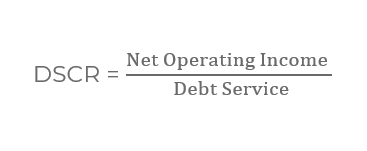
Cap rate
We define the cap rate as the proportion of a property’s net operational income (NOI) to its value. Like the other performance indicators, the cap rate is a relevant indicator, which implies that a good cap rate in one market may be judged unfavorable in another. The following formula computes the cap rate is -
The cap rate is a valuable indicator that gauges converting a single payment or a series of payments into a single value, such as in perpetuity.
Capitalization refers to the process of transforming income into a single monetary value. This measurement is captured in a single value by the cap rate. It’s similar to the return on a financial instrument like a certificate of deposit.
Learn More
The net operating income (NOI) is the gross scheduled income minus vacancy, credit loss, and operating expenses.
Insurance, utilities, maintenance, and other costs are included in operating expenses but do not include mortgage payments, depreciation, or income taxes.
As a result, the NOI stands for net income before debt service and income taxes.
Cap rate, like GRM, is not a cash flow metric. You may borrow up to the ridge beam on the property, eliminating any chance of a positive cash flow. That deception would have no impact on the property’s NOI and thus no impact on its cap rate.
Cap rate, unlike GRM, is not solely determined by income. It depends on net income, which is money after deductible operational expenses.
Discounted cash flow
The most straightforward and concise definition of an investment is the present value of a projected future income stream.
When you break down this concept, you can see the advantages and disadvantages of yet another metric known as discounted cash flow analysis (DCF):
- The term “present worth” refers to the fact that you must consider the time value of money.
- Anticipated implies a degree of ambiguity. You will have to make assumptions regarding events (i.e., cashflows, sales) that have not yet transpired.
- A future income stream implies that you will be looking at more than just a single moment in time; you anticipate a sequence of cashflows, the timing and quantity of which will influence the success of your investment.
To learn everything about DCF calculation, check out the latest post - How to use discounted cash flow for real estate valuation.
Internal Rate of Return
The Internal Rate of Return (IRR) is a profitability measure used to assess the potential return of an investment opportunity.
The IRR is the rate at which the present value of future cash flow from an investment equals the initial investment. In other words, it is the discount rate that makes the net present value (NPV) of an investment equal to zero.
To calculate IRR, you need to know the following:
-
The initial investment amount
-
The cash flows for each period
-
The discount rate
- The initial investment amount is the money you put into the project.
- The cash flows are the payments you receive (or expect to receive) from the project over time.
- The discount rate is the rate you would like to evaluate the cash flows (e.g., the risk-free rate or the average return on an investment in a similar project).
Once you have these three inputs, calculating IRR is fairly simple. You can use a financial calculator or spreadsheet software to find the IRR directly. Or, if you prefer not to use these tools, some online calculators will calculate IRR for you automatically.
If you’re investing in real estate, it’s important to pay attention to your IRR when calculating return on your real estate investments. It will help you determine whether or not a given property is likely to be financially viable over time and whether or not it represents a good opportunity for you.
Learn More
Factors that can reduce the return on Investment (ROI)
Several factors can reduce the real estate return on investments (ROI). The most common reason for a lower ROI is simply due to market conditions; however, there are other potential reasons.
1) Unfavorable market conditions
If the overall market conditions are not favorable, generating a high ROI will be more difficult. Sometimes the market can drop significantly in value without warning.
2) Poor investment choices
Another reason for a lower ROI is simply poor investment choices. If you choose to invest in risky properties that are not doing well, it is more likely that you will lose money rather than make a profit.
3) High fees and expenses
Some investments come with high fees and expenses, which can increase your profits and reduce your overall ROI.
4) Taxes
Taxes can also reduce your ROI because you will have to pay taxes on any profits you earn.
5) Inflation
Inflation can also reduce the purchasing power of your real estate investment returns, which means that you will not be able to buy as much with the money that you earn.
It can erode your ROI over time, so it is important to consider inflation when calculating your expected return.
Several factors can reduce the return on investments (ROI). However, if you are aware of these potential risks and make smart investment choices, you can still generate a healthy return even on your average real estate investment.
Things to consider when calculating real estate ROI
When calculating a real estate ROI, there are a few key things to keep in mind:
- The amount of money you’ve invested in the property
- The amount of time you’ve held the property
- The annual rental income generated by the property
- The costs of ownership and maintenance
For example, if you’ve invested $100,000 in a rental property, but it has only generated $5,000 in annual rental income over the past year, your ROI may be relatively low.
On the other hand, if you’ve held a property for several years and it has generated stable rental income each month with minimal maintenance costs, your ROI could be quite high.
Why is calculating ROI important for real estate investment property?
Real estate investing is a long-term commitment - calculating ROI can help you decide whether or not to sell an investment property.
Represents the income-producing assets’ potential. The higher the ROI, the greater the potential return on investment.
Calculating ROI is important because it:
- Helps you understand the profitability of a real estate investment opportunity.
- Assists in making informed decisions about selling an investment property.
- We can use ROI as a benchmark to compare different real estate investments.
ROI analysis provides a concise way to compare different real estate investments. It can also help investors identify properties that have the potential to generate high returns.
Cash transaction vs financed transaction
When it comes to real estate investing, there are two types of transactions that you can make: cash or financed.
A cash transaction means that you pay the total price in cash upfront, while a financed transaction involves making monthly payments to cover the cost of the property.
Both types of transactions have their pros and cons. When weighing the different options, calculating real estate ROI is an important factor to consider.
To calculate return on investment for each type of transaction, you need to consider both your upfront costs and any ongoing expenses associated with owning the property. It will help you determine which method is most profitable for you in the long run.
Ultimately, choosing a cash or financed transaction depends on your financial situation and investment goals. However, calculating ROI can help you make a more informed decision about which type of transaction is right for you.
Conclusion
When it comes to real estate, making decisions based on return on investment (ROI) is key. By understanding the different methods of ROI calculations and what can affect it, you can make better choices about your investments.
Above we discussed all the important factors to consider when measuring ROI in real estate, as well as the benefits of using this analysis. So, how will you start incorporating ROI into your real estate decisions?
You can become a successful real estate investor by enrolling in one of these structured property development courses.
FAQs
What is the 1 per cent rule in real estate?
The 1% rule is a simple way to estimate the minimum amount of rent you need to charge to cover all your expenses related to owning and operating a rental property.
The rule says that your rent should be at least 1% of the total value of the property ( purchase price + any repairs/improvements). For example, you purchase a rental property for $200,000 and spend an additional $20,000 on repairs and improvements.
The 1% rule would dictate that you charge a minimum of $2,200 per month in rent ($200,000 x 1%).What are KPIs in real estate?
KPIs, or key performance indicators, are essential for any successful real estate business. By tracking KPIs, you can pinpoint areas of your business that need improvement and set goals to improve your overall performance.
There are many different KPIs that you can track in real estate, but some of the most important ones include:
The number of new leads you generate each month
The percentage of leads that convert into clients
The average commission rate you earn on each deal
The number of properties you sell each month/year
Your gross revenue and net profit marginsTracking KPIs is essential to the success of any real estate business.
